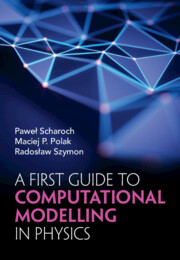Book contents
- Frontmatter
- Contents
- Preface
- How to Use the Book
- First Steps
- Project 1: Rectangular Finite Quantum Well – Stationary Schrödinger Equation in 1D
- Project 2: Diffraction of Light on a Slit
- Project 3: Pendulum as a Standard of the Unit of Time
- Project 4: Planetary System
- Project 5: Gravitation inside a Star
- Project 6: Normal Modes in a Cylindrical Waveguide
- Project 7: Thermal Insulation Properties of a Wall
- Project 8: Cylindrical Capacitor
- Advanced Projects
- Project 9: Coupled Harmonic Oscillators
- Project 10: The Fermi–Pasta–Ulam–Tsingou Problem
- Project 11: Hydrogen Star
- Project 12: Rectangular Quantum Well Filled with Electrons – The Idea of Self-Consistent Calculations
- Project 13: Time Dependent Schrödinger Equation
- Project 14: Poisson’s Equation in 2D
- Appendix A: Supplementary Materials
- Further Reading
- Index
Project 12: - Rectangular Quantum Well Filled with Electrons – The Idea of Self-Consistent Calculations
Published online by Cambridge University Press: 01 February 2024
- Frontmatter
- Contents
- Preface
- How to Use the Book
- First Steps
- Project 1: Rectangular Finite Quantum Well – Stationary Schrödinger Equation in 1D
- Project 2: Diffraction of Light on a Slit
- Project 3: Pendulum as a Standard of the Unit of Time
- Project 4: Planetary System
- Project 5: Gravitation inside a Star
- Project 6: Normal Modes in a Cylindrical Waveguide
- Project 7: Thermal Insulation Properties of a Wall
- Project 8: Cylindrical Capacitor
- Advanced Projects
- Project 9: Coupled Harmonic Oscillators
- Project 10: The Fermi–Pasta–Ulam–Tsingou Problem
- Project 11: Hydrogen Star
- Project 12: Rectangular Quantum Well Filled with Electrons – The Idea of Self-Consistent Calculations
- Project 13: Time Dependent Schrödinger Equation
- Project 14: Poisson’s Equation in 2D
- Appendix A: Supplementary Materials
- Further Reading
- Index
Summary
This chapter covers the problem of a single quantum well filled with electrons, specifically, the changes that occur when electrons are introduced into an empty quantum well. Utilising the ’jellium’ model, the chapter commences by identifying the energy levels of an empty quantum well composed of infinite dipole planes filled with positively charged jellium. The subsequent introduction of electrons leads to a significant change in the well’s shape due to interactions within a non-uniform electron gas. However, the complexity of this problem is simplified by considering only Hartree interactions, allowing for self-consistent calculations. The density of the negative charge introduced is determined, then added to the uniform density of the jellium, resulting in a new potential energy shape of the well. The iterative process of determining new energy levels, populating them with electrons, and re-evaluating continues until a chosen property converges. The chapter concludes by demonstrating how to model the potential of an empty well and how this potential changes in a self-consistent procedure when the well is filled with electrons.
Keywords
- Type
- Chapter
- Information
- A First Guide to Computational Modelling in Physics , pp. 78 - 80Publisher: Cambridge University PressPrint publication year: 2024

